Nairobi Travel Guide
Nairobi is a place of enormous energy and the gateway to some of Africa's best adventures. The city centre buzzes with the aspirations and opportunism of moneychangers, safari touts and vendors, and is a bold counterpoint to the natural beauty that covers other parts of the country.
Kenyatta Avenue is the city's favourite tourist image, with the broad roadway fringed by trees and flowers originally designed to allow a twelve-oxen team to make a full turn. There are several museums and places of interest in the centre, including the National Museum and Snake Park.
Visitors will find numerous markets selling traditional crafts, especially the popular Masai Market, and the nearby Bomas of Kenya host performances of traditional dancing and singing. The Langata Giraffe Centre offers guests the chance to hand-feed the Rothschild's giraffes that inhabit the area.
The Nairobi National Park lies on the southern outskirts of the city and gives an outstanding preview of what Kenya has to offer as a safari destination. Many of Africa's most iconic creatures wander the grasslands against a backdrop of shimmering skyscrapers, including lions, hyenas, leopards, cheetahs, zebra, and the world's densest concentration of black rhinos. Around 400 bird species reside within the park's wetland areas; hippos usually occupy a pool at the confluence of the Mbagathi and Athi rivers.
Things to do in Nairobi
Nairobi is the largest city between Johannesburg and Cairo, and a visit will give travellers insight into the many facets that make up urban Africa. The main reasons people travel to Nairobi are to either launch into one of Kenya's famous wildlife safaris or else travel to the coast. However, the city itself offers buzzing markets, some interesting sightseeing and a lively nightlife.
It's a shame many visitors to Kenya don't spend too long in Nairobi, as it's a welcoming and fascinating place with a range of worthwhile things to see and do. A day or two is all visitors will need to get the highlights package before setting off on their Kenyan adventures.
It's a good idea to hire a taxi driver based on a hotel recommendation hotel. Some of the top attractions are the National Museum, the delightful Giraffe Centre, the Karen Blixen Museum, and the Sheldrick Elephant Orphanage, not to mention the national park on the city's doorstep. A holiday in Nairobi can be taken virtually any time of year, although the summer months (November to February) are most popular.
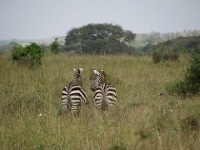
Nairobi National Park and Sheldrick Elephant Orphanage
Nairobi National Park is a compact and beautiful area of plains and wild bush that contains a large number of Africa's best-known animals. Large herds of zebra, wildebeest, buffalo and giraffe roam the plains, alongside black rhino, ostrich, baboons, cheetah, leopard and lions. The park also contains the Animal Orphanage, where sick, wounded and abandoned animals are cared for and rehabilitated, as well as an Educational Centre featuring a Safari Walk. Close by is the Sheldrick Elephant Orphanage, where infant elephants and rhino orphaned because of poaching activities are looked after and eventually returned to the wild in Tsavo National Park. The centre is open every morning and visitors can watch the calves bathing in the mud hole and being bottle fed by human surrogate mothers.
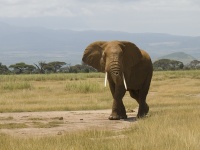
Amboseli National Park
Amboseli is a park of giants, renowned for its herds of mighty tusked elephants and presided over by the magnificent backdrop of Africa's highest mountain, Kilimanjaro. One of Africa's most unforgettable images is the picture of these large creatures standing in silent reverence before the gigantic snow-covered mountain just over the border in neighbouring Tanzania.
Observation Hill rises from the centre for breathtaking views over the park and towards Mt Kilimanjaro, especially in the pink light of dawn. Meaning 'Place of Water' in the Maasai language, it has a continuous supply from Kilimanjaro's snowmelt, forming underground springs that feed the marshy patches and swamps that are home to hippos and a great variety of bird life. Predators are relatively scarce, apart from jackal and hyena, but there are large numbers of grazers such as wildebeest, zebra and gazelles on the grassy plains and giraffe among the thorn trees.
A popular way to take in the scenery is by way of a noiseless microlight flight, either from Nairobi or the Amboseli airstrip. There is a wide range of accommodation in and around the outskirts of the park for those wanting to extend the experience. Amboseli National Park is 134 miles (215km) southeast of Nairobi; the drive takes about 4 hours.
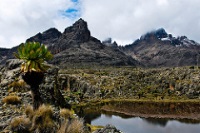
Mount Kenya National Park
This national park encompasses Africa's second highest mountain, Mount Kenya, an extinct volcano with a series of jagged snow-covered peaks. The local Kikuyu people revere the mountain they call Kirinvaga ('mountain of whiteness') as the home of their Supreme Being, Ngai, and traditionally Kikuyu homes are built to face the sacred summit.
Part of the attraction is the incredible variation in flora and fauna due to the changes in altitude and its position on the equator. A favourite with hikers, the slopes are covered in thick forest, and have a variety of animals such as the black leopard.
Bamboo, moorland and alpine vegetation give way to rock, ice and one of the world's rarest sights: equatorial snow. For those not wishing to climb, the park offers a pristine wilderness, lakes and glaciers, and is good for game viewing and hiking.
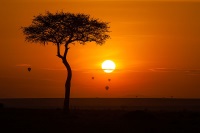
Masai Mara National Reserve
Commonly known as the Mara, Kenya's most visited park is a wildly beautiful place with rolling savannah grasslands. It's an extension of the Serengeti Plains in neighbouring Tanzania and offers wonderful views and an extraordinary concentration of wildlife, including the Big Five. Its large grazing herds attract many other predators such as cheetah, leopard and hyena.
The annual highlight is the Great Wildebeest Migration, when an estimated two million animals leave the dry plains of Tanzania to seek greener pastures in the north, arriving in the Mara from late June. Their entrance into the Mara makes a breathtaking spectacle, as they cross the crocodile infested waters of the Mara River. Also within the reserve is a Masai village that holds demonstrations of traditional dance and music. The proud warriors have become a symbol of tribal Kenya with their beadwork, spears and red blankets.
The Masai Mara is 167 miles (270km) west of Nairobi and most visitors travel there by road. The most popular experience is to book guided drive-in safari that often includes overnight stays in the Amboseli and Lake Nakuru National Parks.
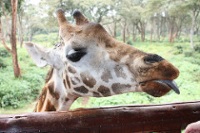
The Giraffe Centre
At the Giraffe Centre, visitors can experience the rare pleasure of hand-feeding these graceful and gentle creatures from a platform at eye-level. They can also enjoy its nature walks, along which they'll see 160 species of bird among incredible trees, and warthogs and giant tortoises down below. This is the single best attraction for children in Nairobi and there are often groups of school kids that come for tours. Guides at the centre give educational talks and answer any questions visitors may have.
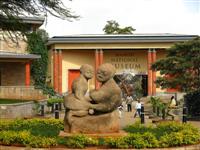
Nairobi National Museum
The Nairobi National Museum is home to the great prehistoric finds from the Leakey family, including relics from mankind's earliest ancestors. The most famous fossil is the 1,5 million-years-old Turkana Boy, the most complete early human skeleton ever found. There are also fascinating sections on art, wildlife and local history.
In many ways, it's a bit old-fashioned but a great place to learn about Kenya's culture and history. Local guides are available at the museum, with their knowledge enriching the exhibits. Apart from the wealth of artefacts and information in the museum, there are some wonderful sculptures and a herb garden, and also an attached snake park containing large venomous snakes, tortoises and crocodiles.
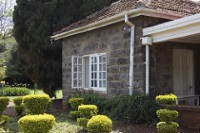
Karen Blixen Museum
Karen Blixen was a notable Kenyan personality who lived and farmed on the outskirts of Nairobi from 1917 to 1931, when she returned to Denmark bankrupt and heartbroken at being forced to leave Africa. She authored acclaimed books including Out of Africa, which inspired an Oscar winning film of the same name.
The main building of the original farmhouse, M'Bogani House, now houses the Karen Blixen Museum and retains much of its original furniture and items of interest. The museum is situated in the suburb of Karen, a short drive from the city centre.
The stunning landscapes of the area, however, will be instantly recognisable. Those who have seen the much-loved movie may also be curious about the Muthaiga Country Club. Tourists can visit the original clubhouse, which is still active, but women won't be allowed in the members' bar.
Eating Out
Nairobi is not among one of the world's best-known gastro-tourism destinations, but its flourishing food scene punches well above its weight. Colourful, boldly flavoured and modestly priced, the city's cuisine will be a highlight of any visit.
Nyama Choma is perhaps the city's (and indeed Kenya's) most famous dish, and it translates simply as 'barbecued meats.' Though the tradition of eating this barbecued meat goes back many generations, Nairobi's place on the global stage has led to the dish being infused with flavours from Europe, Asia and other parts of Africa.
Nairobi's cultural history has also influenced its cuisine, which among other things features cucumbers and tomatoes from Europe, and spicy dishes brought over from India during the age of the British Empire. Visitors should make a point of trying local staples such as ugali, a doughy cornmeal porridge that's served with goat stew.
Shopping
Nairobi is possibly the best place in Africa to stock up on crafts and curios. The quality and prices of goods is unmatched so visitors should make the most of a stay here to stock up. Local vendors will test travellers' bargaining skills so visitors should be prepared to haggle over typical souvenirs such as Kamba woodcarvings, African masks and Kisii soapstone carvings, as well as Maasai beadwork, colourful fabrics and the distinctive square cloth known as kanga and kikoi.
The best place to go on a shopping excursion is the fascinating and always lively City Market on Muindi Mbingu Street. For a more local experience, travellers should visit Kariokor Market, where everything from vegetables to clothes is on sale. More local crafts can be found at the Maasai Markets. Biashara Street in central Nairobi is lined with interesting stores and boutiques, and there are plenty of cafes in which to recuperate from the rigors of shopping.
Taxi drivers and local touts will pressure new arrivals to go to certain stores. They earn large commissions for doing so, and the prices tourists are expected to pay will be much higher.
Nightlife
Nairobi is one of the premier nightlife cities in Africa, where visitors will find a bustling scene full of enticing options. Most people begin their evening at a bar or restaurant before heading to one of the top nightclubs in the posh suburbs of Westlands, Kilimani, Lavington, Thika Road and Mombasa Road.
Many of the dance venues have a distinctly international flavour as there are many foreigners and expats in Nairobi. However, there are also several opportunities to get a taste of local dance music genres such as gengetone, a high-energy, dance-ready sound that blends rap with reggaeton and dancehall infusions.
Travellers who'd prefer a slower pace should try one of the city's jazz venues, or Kenya National Theatre, which offers a mix of plays, talks and exhibitions.
Getting Around
The most popular form of public transport in Nairobi are matatus, minibuses that operate on set routes. Cheap but unregulated, these overcrowded vehicles have become part of Kenyan culture. No less risky are the local bus services, renowned for speeding and dangerous driving.
Taxis are widely available and convenient, usually congregating around hotels and areas frequented by tourists. If they aren't metered, the fare should be agreed upon before departure. Nairobi taxis are marked with a yellow line along the side of the vehicle, or appear as large black London taxis.
The better taxi companies have more modern vehicles, which are booked by telephone. The best option if visitors are spending a day or two in the city is probably to hire a taxi and driver recommended for them by their hotel or tour operator. Three-wheel auto-rickshaws, or tuk-tuks, are also used as taxis in Nairobi. Walking in the city can be dangerous and is not a good idea after dark or outside of tourist areas.
Nairobi Climate and Weather
Nairobi has a maritime climate, tempered by its high elevation and tends to be less hot than the rest of Kenya. As the city is near the equator there is little variation between the seasons and generally people talk about wet or dry seasons as opposed to summer, winter, spring, or autumn. However, summers, between November and February, are warm and pleasant, with temperatures ranging between 50F (10C) and 77F (25C).
Winter days, between June and August, are mild with slightly cooler evenings, but temperatures are much like summer. The rainy season in Nairobi is during late summer and into autumn, when it is often cloudy and damp, but rainfall is seldom very heavy. The drizzliest months are March to May and October to December.
Generally visitors flock to Kenya in the country's dry seasons between January and March, and July and October, as these are the best months to go on safari in the national parks. The best time to visit Nairobi is in summer between November and February, but ultimately any time of year is okay in the city and it is recommended that visitors decide on the time of their visit to Kenya according to their desired activities rather than the city's climate.
Kenya travel info
Electricity
The electrical current is 240 volts, 50Hz. UK-style square three-pin plugs are used.
Language
English is the official language but Swahili is the national language, with 42 ethnic languages spoken.
Money
The unit of currency is the Kenyan shilling (KES), which is divided into 100 cents. It is not advisable to take Kenyan Shillings out of the country, as they are difficult to exchange elsewhere. Foreign currency can be changed at banks, bureaux de change and hotels. It's easiest to exchange US dollars, pounds sterling or euros. International credit cards are accepted in the larger hotels and stores, and some camps and lodges. ATMs are widely available in Nairobi and other major towns.
Tipping
Tipping is not customary in Kenya, though a 10 percent service charge may be added to the bill in more upmarket restaurants. Small change in local currency may be offered to taxi drivers, porters and waiters; safari drivers, guides and cooks often rely heavily on tips to get by, but these are discretionary.
Health
Travellers should get the latest medical advice on vaccinations and malaria prevention at least three weeks prior to departure. A malaria risk exists all year round in Kenya, but more so around Mombasa and the lower coastal areas than in Nairobi and on the high central plateau. Immunisation against yellow fever, polio and typhoid are usually recommended. A yellow fever certificate is required by anyone arriving from an infected area. Other risks include diarrheal diseases. Protection against bites from sandflies, mosquitoes, and tsetse flies is the best prevention against malaria and dengue fever, as well as other insect-borne diseases, including Rift Valley fever, sleeping sickness, leishmaniasis and Chikungunya fever. Water is of variable quality and visitors are advised to drink bottled water. There are good medical facilities in Nairobi and Mombasa but travel insurance is always advised.
Safety
There is a threat from Somali terrorist groups in Kenya and visitors should be vigilant in public places and tourist sites. Several bombings have targeted Mombasa, Nairobi and other cities in recent years, most blamed on the Al Qaeda-linked Al-Shabaab group. Several governments have instituted travel warnings and alerts for parts of Kenya and travellers are advised to read up on the situation and which areas should be avoided before visiting the country.
Visitors should be alert to the threat of robberies and muggings at all times in Nairobi, but particularly at night. They should also be vigilant in Mombasa.
Banditry occurs in the northern areas and there have been armed attacks in the resort areas of northern Kenya near the border of Somalia. Several governments have advised against all but essential travel to coastal areas within 93 miles (150km) of the Somalian border, and inland areas within 37 miles (60km) of the border.
Piracy has also been a concern off the coast of Kenya. There have previously been incidents of attacks and hijackings of private vessels, though there have been no recent reports. Visitors should also take sensible precautions when driving. In particular, landmines have been used in attacks around Moyale, close to the main A2 road south. Vehicles crossing the border at this point should stay on the A2.
Local customs
Taking of photographs of official buildings is not advised and could lead to detention; photography is prohibited at airports. Coastal towns are predominantly Muslim and religious customs and sensitivities should be respected, particularly during Ramadan. Dress should be conservative away from the beaches and resorts, particularly for women. Homosexuality is against the law. Smoking in public places is illegal, other than in designated smoking areas, and violators will be fined or imprisoned.
Doing business
Business in Kenya tends to be conducted formally and conservatively, with the appropriate attire of a jacket and tie. Patience, cultural sensitivity, tolerance for uncertainty and the ability to build personal relationships with business associates are all central to successfully doing business in the country.
Ethnic division and corruption undermine the Kenyan economy, but they are realities in the business world of Kenya. Despite red tape and numerous pitfalls, Kenya is a land of business opportunity and the IT and telecoms sectors are rapidly expanding.
The concept of harambee is important in local business culture, and involves a sense of community, responsibility and mutual assistance. Deference to seniority is important, as is social standing, while using official titles is key during introductions and greetings.
Terse statements should be avoided and controlling one's emotions is vitally important. While punctuality is key and meetings should begin on time, they often don't end on time. When introducing a new deal, it's important to illustrate respect for tradition and history. Deals generally only close when it is clear that all the possible information has been considered and deliberated upon.
Interpersonal relationships add to business success, and understanding Kenyan culture and history is a great way of building business contacts. Building a solid business relationship is prioritised over meeting deadlines and closing deals.
English is the language of business. Business hours run from 9am to 5pm on weekdays and dress style should be formal with suits or smart-casual wear. Gifts are important and generally expected. Taking time to greet everyone and enquire about the health of their family will ensure a smooth business meeting.
Respect for elders is important too, and if foreigners are invited to dinner, they should never begin eating until the eldest member has started. Also, foreigners should refrain from leaving food on their plate. In introductions, clasping an elder or key business associate's wrist with the other hand while shaking hands conveys respect.
Duty free
Travellers to Kenya over 18 years do not have to pay duty on 250g tobacco products; 1 litre of spirits; and 500ml perfume. Prohibited items include fruit, imitation firearms, and children's toys pistols. No plants may be brought into the country without a Plant Import Permit (PIP).
Communications
The international access code for Kenya is +254. Area codes are also in use. Purchasing a local SIM card is simple and most hotels, restaurants and cafes in tourist areas offer free WiFi access.
Passport & Visa
All foreign passengers to Kenya must hold proof of sufficient funds to cover their stay in the country, return or onward tickets, and the necessary travel documentation for their next destination. Most foreign nationals require a visa, and some foreign nationals can obtain visas on arrival in Kenya, provided that their passport is in good condition, and they have at least one blank page in their passport for the visa endorsement. The visa fee is payable in USD, GBP or EUR, cash only. On-arrival visas are valid for three months. It is also possible to obtain an e-visa prior to departure for Kenya. A valid, 90 day, multiple entry or re-entry "East African Tourist Visa" issued by Rwanda or Uganda will suffice, provided the passanger in posession of the document has previously entered the country that first issued the visa. A yellow fever vaccination certificate is required to enter Kenya if arriving within six days of leaving or transiting through an infected area. It is highly recommended that travellers' passport have at least six months' validity remaining after the intended date of departure from their travel destination. Immigration officials often apply different rules to those stated by travel agents and official sources.
Entry requirements
US citizens must have a passport that is valid for at least six months beyond the date of their arrival in Kenya. A visa is not required, but travellers must obtain an Electronic Travel Authorization (eTA) online before departure.
UK citizens must have a passport that is valid for at least six months beyond the date of their arrival in Kenya, with at least two blank pages. A visa is not required, but an eTA must be obtained online before travel.
Canadian citizens must have a passport that is valid for at least six months beyond the date of their arrival in Kenya. A visa is not required, but travellers must apply for an eTA online before arrival.
Australian citizens must have a passport that is valid for at least six months beyond the date of their arrival in Kenya. A visa is not required, but an eTA must be obtained online prior to travel.
South African citizens must have a passport that is valid for at least six months beyond the date of their arrival in Kenya. A visa is not required, but travellers must still apply for an eTA online before travel. South African citizens are exempt from the eTA fee.
Irish citizens must have a passport that is valid for at least six months beyond the date of their arrival in Kenya. A visa is not required, but an eTA must be obtained online before departure.
New Zealand citizens must have a passport that is valid for at least six months beyond the date of their arrival in Kenya. A visa is not required, but an eTA must be obtained online before travel.
Useful contacts
Kenyan Tourist Board: +254 (0)20 271 1262 or www.magicalkenya.com
999 (General Emergencies)


